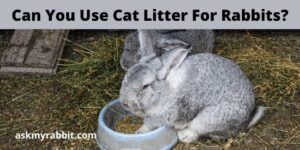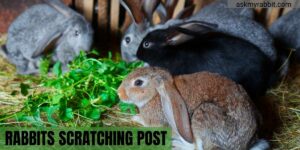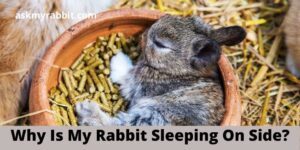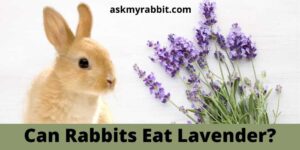At times you may want to give your rabbit a nice treat that’s fresh and homemade. Wheatgrass may seem like a healthy option to rabbit parents as a treat. I like to treat my Boots and Rogers with wheatgrass from time to time.
Yes, rabbits can eat wheatgrass. Wheatgrass is the best way for your bunny to get his daily dose of nutrition. If you have an old food bowl or litter box that you no longer use, you may quickly grow wheatgrass in a container at home. Your rabbit may enjoy wheatgrass as a treat from time to time.
Rabbits above the age of twelve weeks may safely consume wheatgrass. My babies love to consume and nibble on wheatgrass. If you’re feeding your rabbits for the first time, stick to fifteen-gram serving size. Gradually work your way up from there.
In this article, we will inform you all about wheatgrass and the excellent way it can be used as a rabbit treat. So, keep reading.
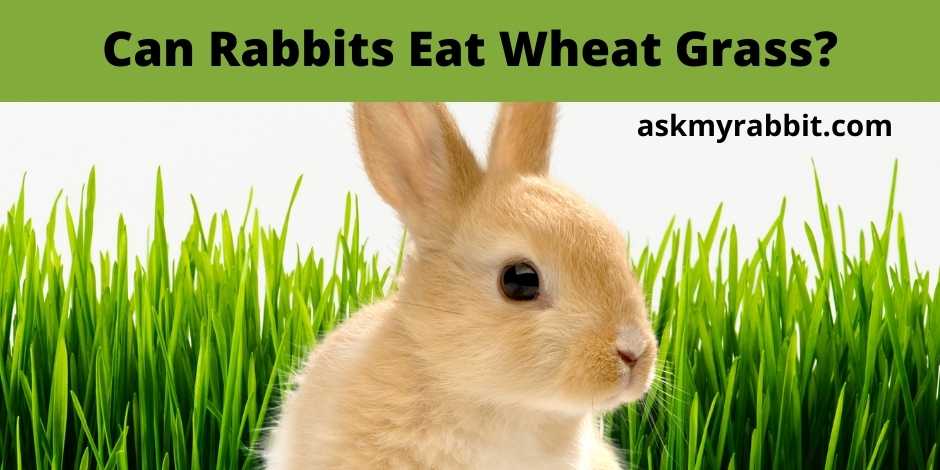
Is Wheat Grass Good For Rabbits?

Yes, wheatgrass is good for bunnies. It is one of the most widely suggested foods for rabbits because of its nutritious value. Wheatgrass is the only food wild rabbits would consume if they ever come upon it.
Rabbits kept as pets will consume wheatgrass as soon as you leave them alone. My little bunnies are no exception. Wheatgrass is a favourite of both of my bunnies. Therefore, every time I prepare wheatgrass juice, I share some with them.
If you keep wheatgrass to the suggested dosage and your rabbit is of the appropriate age for wheatgrass consumption, it is perfectly safe for them to consume it as a treat.
Wheatgrass can only be harmful to your rabbit if you overfeed it. If your bunny substitutes wheatgrass for hay, it might be a problem.
Do not neglect any instructions to avoid stomach issues in young rabbits since they are more vulnerable. It is essential to know how much wheatgrass your rabbit can consume.
Can Rabbit Eat Wheatgrass Daily?
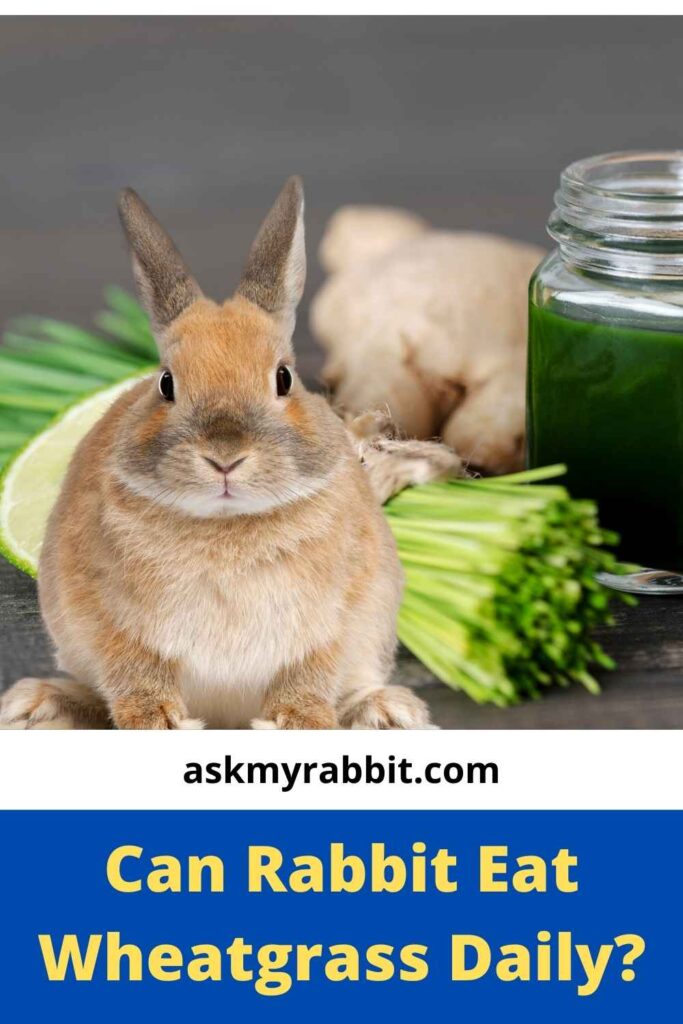
No, rabbits should not eat wheatgrass daily. You should always include a variety of vegetables in your rabbit’s diet. Otherwise, it may cause stomach issues in your rabbit.
Wheatgrass alone cannot meet your rabbit’s nutritional demands. Therefore, we recommend that you only provide it as a treat on an occasional basis.
Overfeeding in rabbits is the primary cause of the danger related to wheatgrass. Rabbits overfeeding on food other than hay is unhealthy. This is because they won’t get the fibre they need for their bodies to function correctly.
Overfeeding wheatgrass may lead to the following issues in bunnies:
1. Stomach Blockage
Overfeeding wheatgrass instead of hay may lead to gastrointestinal blockage in rabbits. This is due to the absence of fibre in wheatgrass.
2. Diarrhea
Diarrhea also happens when rabbit owners overfeed their animals’ wheatgrass too quickly. We recommend that you slowly transition your rabbits to a new diet.
3. Cecotropes
When rabbits consume a lot of wheatgrass instead of hay, soft uneaten cecotropes are also conceivable. Softer cecotropes might result from a lack of fibre.
Pet rabbits may eat wheatgrass from the garden. This is provided that it is not treated with pesticides and is fresh. Don’t let a rabbit consume a lot of wheatgrass right away since her stomach requires time to acclimate to it.
Can Rabbits Eat Wheat Fodder?
Yes, rabbits can eat wheat fodder. It is a healthy treat that may be given to bunnies from time to time. You may also grow wheat fodder in your garden.
Buying wheat grain is the first step in growing wheat fodder. Look for grain that hasn’t been cooked and hasn’t had the chaff removed. They may be utilised, but they will need to be cleaned. Check with local feed mills to see if they have what you’re looking for.
The second step is to get some trays. Fodder racks intended to suit lunch meat containers can be used. A wide shallow tray or clear and solid containers are the finest choices. The roots of wheat fodder flourish in dark pans. You’ll need ten to twelve of the same trays to grow wheat fodder.
Punch holes on the bottom of your trays with a hot nail to allow water to drain. Melt holes in the tray by placing the tip of the torch in a flame until it’s hot. You may add one or more holes on the side or base.
On the side, the tray may be tilted over to drain completely. To ensure that the seeds have a proper soak, carefully fill the trays with water and drain them.
Using a deep tray, add a layer of dry grain to cover the surface. Count the grain and then pour it into a pint container. Consider adding a bit more grain to your recipe since part of it will be pulverised away in the following step.
Wet the seeds by sprinkling water over them and swiping them around. You’ll see a layer of floaters if you put the jar on the ground. Debris like immature seeds will rise to the top of the mixture.
Before sprouting, they need to be removed. Otherwise, they will degrade with the feed. First, let it soak for a few minutes to get rid of any trapped air bubbles.
Then, remove the floaters from the seeds by pouring them out. The waste will be caught in a tiny strainer. Swirl the water in the jar four to five times to eliminate any remaining chaff.
A few drops of bleach may be added to the jar. Mix it up by swirling. To remove mould and fungus, use bleach to destroy the spores. The grain should be allowed to soak for eight to twelve hours after being washed. It’s possible that part of the grain may ferment over the longer soak durations.
Pour the grain onto a tray and let it sit for a few minutes. Drain the water, then shake to level. Make sure to keep your hands away from the seeds. The drainage holes should be facing outward when sliding the tray into the rack.
You may put a loose cover in the tray for the first several days to promote humidity. Remove the lids to water the plants and to see the sprouting process.
Then, water the trays twice daily. Improve germination by watering the younger trays three times each day. The feed rack should be placed in the sink.
Allow water to trickle from the top trays into the trays below. Drain any remaining water by tilting the rack backwards. Make sure the roots aren’t drowning in water.
Every day, repeat the previous steps until you have at least nine to ten trays growing. The soaked grain in the earliest trays will be replaced by lush grass with a good root mat in the oldest trays.
Younger dishes may be placed on a shelf. Green up the older trays by placing them near a window or beneath a fluorescent light.
The last step is to inspect your wheat fodder. Roots and clean seedbeds make up a healthy fodder mat. When the roots are cut, they emit a subtle cucumber scent.
You should avoid feeding it to your animals if it is mouldy or has a terrible odour. You’ll get the hang of it quickly if you put in the time and effort to cultivate your feed.
Harvest the oldest tray every day. Cut the mat into serving-size pieces using scissors or kitchen shears after removing it from the tray.
Your rabbit may either eat the roots or eat the grass. When introducing new items to your diet, do so gradually. Every day, remove any root mats that haven’t been devoured yet.
How To Grow Wheatgrass For Rabbits?
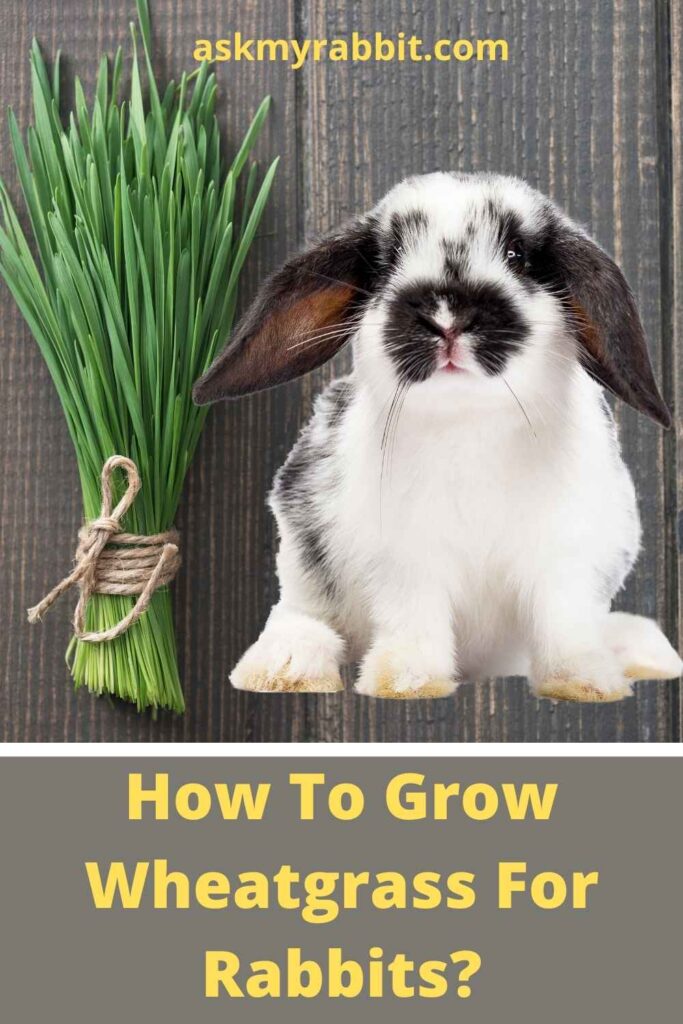
Wheatgrass is the best way to get your bunny his daily dose of nutrition. If you have an old food bowl or litter box that you no longer use, you may quickly grow wheatgrass in a container at home.
Wheatgrass seeds of the highest quality should be organic and fit for human consumption. There are several organic brands of wheatgrass seeds available. To lengthen the shelf life of your wheatgrass seeds, store them in the refrigerator or freezer.
In order to grow wheatgrass, use a container with a depth of no more than three inches. Add a half-inch to a full inch of organic potting soil. Spray it with water to clean it up.
Put a thin coating of the same potting soil on top of the wheatgrass seeds. Then cover the seeds with a second thin layer. Cover the jar with plastic wrap and reapply the spritz.
You might try the seeds in the refrigerator for a few days before planting to encourage more uniform germination.
Instead of placing the container in indirect light, you may put it in the refrigerator for two to three days after starting your seeds and wrapping it in plastic wrap. Your seeds should be returned to room temperature at this point.
The wheatgrass should be checked and sprayed with water several times a day. But at the same time, you don’t want it to be soggy or dry. Just keep it wet and avoid watering too much.
Take off the plastic wrap after the wheatgrass has grown to at least one inch in height after four or five days. Continue to spray the wheatgrass every day until it reaches the desired height.
Wheatgrass is prone to mildew, so keep an eye out for it. It’s time to toss your wheatgrass if the roots begin to mould. You may start a fresh batch by carefully cleaning your container.
What Are The Healthy Alternatives To Wheat Grass?
It is okay for rabbits to consume wheatgrass. However, you should also include other vegetables into their diet.
If you don’t want to offer your bunnies wheatgrass, there are other healthy alternate options available:
- Celery
- Spinach
- Basil
- Clover
Frequently Asked Questions
Can I Feed My Rabbit Dried Grass?
Yes, you can feed your rabbit dried grass. Every species of grass is fair game for rabbits who will consume it. The best grasses for bunnies are those that can be dried and used to create hay.
Can Rabbits Eat Peas?
Yes, rabbits can eat peas. They may be eaten fresh and green. Peas are safe for your pet. Avoid feeding bunnies dry peas since they might create intestinal obstructions. A teaspoon for every two pounds of your bunny’s weight is a good guideline.
Can Rabbits Eat Mint?
Yes, rabbits can eat mint. A tiny amount of mint is okay for rabbits to consume regularly. Mint is one of the few plants that are safe for rabbits to eat.
Final Words
Wheatgrass may be fed to rabbits if they are at least twelve weeks old. If they are not eating wheatgrass as a substitute for hay, you can give them wheatgrass as an occasional treat.
Also, when feeding wheatgrass for the first time, start with fifteen grams per day. Then, gradually increase the amount over a week.
The absence of fibre is the most common cause of digestive issues in rabbits. Therefore, if you only feed your bunny wheatgrass as a treat, he should be okay.
In the comment section below, drop your doubts and queries regarding your baby bunny’s eating habits. We will answer them soon!


